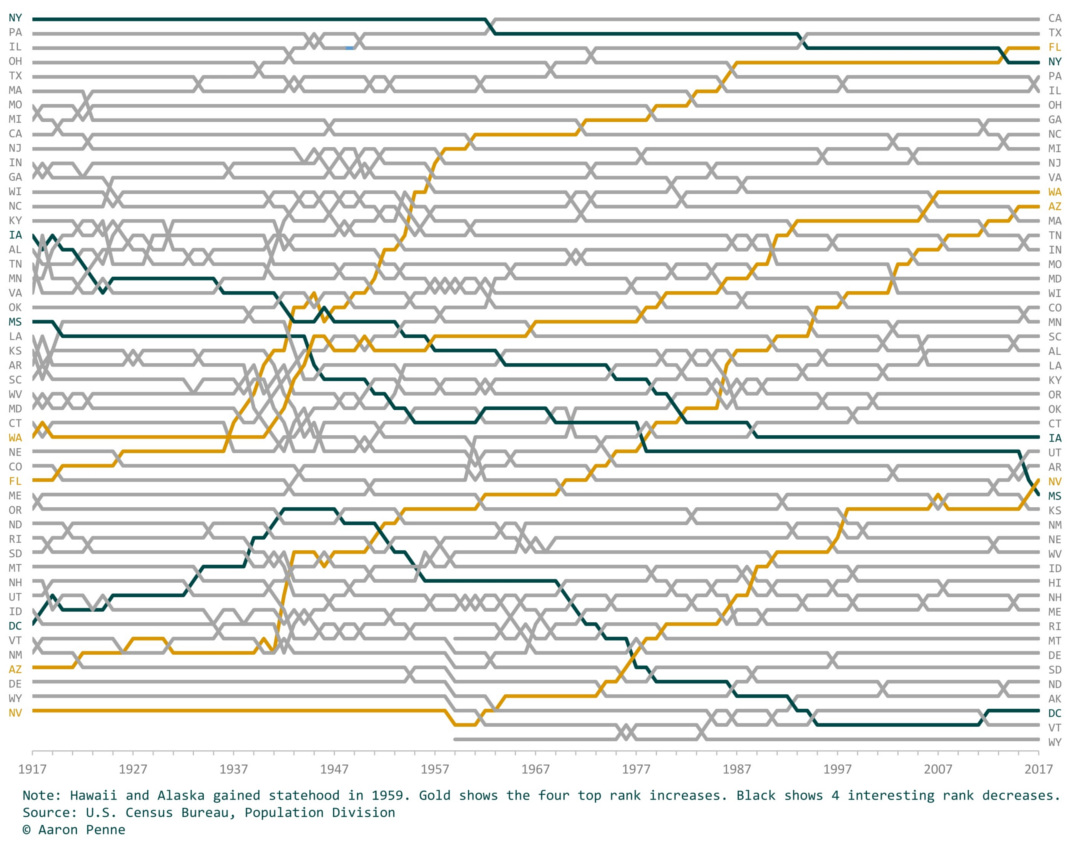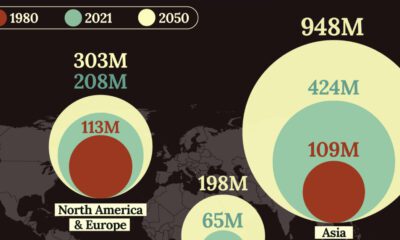Misc
Chart: The Population Rank of Every U.S. State Over 100 Years

The Population Rank of Every U.S. State Over 100 Years
“Go west, young man, and grow up with the country.”
Popularized by Horace Greeley, the editor of the New-York Tribune, these words formed one of the great catchphrases at the height of the Manifest Destiny era in the 19th century.
Although that period is still a few chapters back in the history books, the fact is the West Coast is still relatively new today. Los Angeles was only incorporated in 1850, Portland in 1851, and Seattle in 1869.
And throughout the 20th century – Americans were moving westward in droves, ultimately culminating in California taking over the title of the most populous state in the union by the year 1960.
Population Rank by State
Today’s visualization is a bump chart from Aaron Penne, and it shows the population rank of U.S. states and D.C. over the timeframe of a century (1917-2017) using data from the U.S. Census Bureau.
When a state passes another in population in a given year, it “bumps” the other state from that place in the ranking. Big movers are also highlighted in orange (up) and black (down) on the graph.
Let’s look at the numbers for the first year on the graph, which is 1917:
| Rank | State | Population (1917) |
|---|---|---|
| #1 | New York | 9,993,000 |
| #2 | Pennsylvania | 8,578,000 |
| #3 | Illinois | 6,313,000 |
| #4 | Ohio | 5,510,000 |
| #5 | Texas | 4,563,000 |
| #6 | Massachusetts | 3,738,000 |
| #7 | Missouri | 3,470,000 |
| #8 | Michigan | 3,451,000 |
| #9 | California | 3,171,000 |
| #10 | New Jersey | 2,976,000 |
| #11 | Indiana | 2,910,000 |
| #12 | Georgia | 2,885,000 |
| #13 | Wisconsin | 2,587,000 |
| #14 | North Carolina | 2,546,000 |
| #15 | Kentucky | 2,421,000 |
| #16 | Iowa | 2,382,000 |
| #17 | Alabama | 2,361,000 |
| #18 | Tennessee | 2,331,000 |
| #19 | Minnesota | 2,329,000 |
| #20 | Virginia | 2,313,000 |
| #21 | Oklahoma | 1,960,000 |
| #22 | Mississippi | 1,820,000 |
| #23 | Lousiana | 1,795,000 |
| #24 | Kansas | 1,748,000 |
| #25 | Arkansas | 1,737,000 |
| #26 | South Carolina | 1,675,000 |
| #27 | West Virginia | 1,439,000 |
| #28 | Maryland | 1,428,000 |
| #29 | Connecticut | 1,327,000 |
| #30 | Washington | 1,287,000 |
| #31 | Nebraska | 1,285,000 |
| #32 | Colorado | 910,000 |
| #33 | Florida | 895,000 |
| #34 | Maine | 777,000 |
| #35 | Oregon | 763,000 |
| #36 | North Dakota | 661,000 |
| #37 | Rhode Island | 606,000 |
| #38 | South Dakota | 599,000 |
| #39 | Montana | 505,000 |
| #40 | New Hampshire | 447,000 |
| #41 | Utah | 444,000 |
| #42 | Idaho | 413,000 |
| #43 | District of Columbia | 385,000 |
| #44 | Vermont | 372,000 |
| #45 | New Mexico | 361,000 |
| #46 | Arizona | 311,000 |
| #47 | Delaware | 222,000 |
| #48 | Wyoming | 186,000 |
| #49 | Nevada | 81,000 |
New York led the pack with just short of 10 million people, which made up 10% of the population of the country as a whole. Meanwhile, California had only 3.2 million people – and amazingly, Nevada only had 81,000 people in 1917.
Now let’s jump forward 50 years to 1967, when the U.S. population was closer to 200 million.
| Rank | State | Population (1967) |
|---|---|---|
| #1 | California | 19,176,000 |
| #2 | New York | 17,935,000 |
| #3 | Pennsylvania | 11,681,000 |
| #4 | Illinois | 10,947,000 |
| #5 | Texas | 10,599,000 |
| #6 | Ohio | 10,414,000 |
| #7 | Michigan | 8,630,000 |
| #8 | New Jersey | 6,928,000 |
| #9 | Florida | 6,242,000 |
| #10 | Massachusetts | 5,594,000 |
| #11 | Indiana | 5,053,000 |
| #12 | North Carolina | 4,952,000 |
| #13 | Missouri | 4,539,000 |
| #14 | Virginia | 4,508,000 |
| #15 | Georgia | 4,408,000 |
| #16 | Wisconsin | 4,303,000 |
| #17 | Tennessee | 3,859,000 |
| #18 | Maryland | 3,757,000 |
| #19 | Minnesota | 3,659,000 |
| #20 | Louisiana | 3,581,000 |
| #21 | Alabama | 3,458,000 |
| #22 | Washington | 3,174,000 |
| #23 | Kentucky | 3,172,000 |
| #24 | Connecticut | 2,935,000 |
| #25 | Iowa | 2,793,000 |
| #26 | South Carolina | 2,533,000 |
| #27 | Oklahoma | 2,489,000 |
| #28 | Mississippi | 2,228,000 |
| #29 | Kansas | 2,197,000 |
| #30 | Colorado | 2,053,000 |
| #31 | Oregon | 1,979,000 |
| #32 | Arkansas | 1,901,000 |
| #33 | West Virginia | 1,769,000 |
| #34 | Arizona | 1,646,000 |
| #35 | Nebraska | 1,457,000 |
| #36 | Utah | 1,019,000 |
| #37 | Maine | 1,004,000 |
| #38 | New Mexico | 1,000,000 |
| #39 | Rhode Island | 909,000 |
| #40 | District of Columbia | 791,000 |
| #41 | Hawaii | 723,000 |
| #42 | Montana | 701,000 |
| #43 | New Hampshire | 697,000 |
| #44 | Idaho | 688,000 |
| #45 | South Dakota | 671,000 |
| #46 | North Dakota | 626,000 |
| #47 | Delaware | 525,000 |
| #48 | Nevada | 449,000 |
| #49 | Vermont | 423,000 |
| #50 | Wyoming | 322,000 |
| #51 | Alaska | 278,000 |
In just half of a century, California gained 16 million people, and jumped to the #1 spot in the process. That’s a 504% increase over its 1917 population.
The Largest Increases in Population
For a final table data, we’ll show you the 2017 state populations compared to the 1917 state populations.
The table is sorted by the percentage increase over the course of that 100 years of time.
| Rank | State | Population (1917) | Population (2017) | % Increase |
|---|---|---|---|---|
| #1 | Nevada | 81,000 | 2,998,039 | 3,601% |
| #2 | Florida | 895,000 | 20,984,400 | 2,245% |
| #3 | Arizona | 311,000 | 7,016,270 | 2,156% |
| #4 | California | 3,171,000 | 39,536,653 | 1,147% |
| #5 | Utah | 444,000 | 3,101,833 | 599% |
| #6 | Texas | 4,563,000 | 28,304,596 | 520% |
| #7 | Colorado | 910,000 | 5,607,154 | 516% |
| #8 | New Mexico | 361,000 | 2,088,070 | 478% |
| #9 | Washington | 1,287,000 | 7,405,743 | 475% |
| #10 | Oregon | 763,000 | 4,142,776 | 443% |
| #11 | Delaware | 222,000 | 961,939 | 333% |
| #12 | Maryland | 1,428,000 | 6,052,177 | 324% |
| #13 | Idaho | 413,000 | 1,716,943 | 316% |
| #14 | North Carolina | 2,546,000 | 10,273,419 | 304% |
| #15 | Virginia | 2,313,000 | 8,470,020 | 266% |
| #16 | Georgia | 2,885,000 | 10,429,379 | 262% |
| #17 | Wyoming | 186,000 | 579,315 | 211% |
| #18 | New Jersey | 2,976,000 | 9,005,644 | 203% |
| #19 | New Hampshire | 447,000 | 1,342,795 | 200% |
| #20 | South Carolina | 1,675,000 | 5,024,369 | 200% |
| #21 | Michigan | 3,451,000 | 9,962,311 | 189% |
| #22 | Tennessee | 2,331,000 | 6,715,984 | 188% |
| #23 | Connecticut | 1,327,000 | 3,588,184 | 170% |
| #24 | Lousiana | 1,795,000 | 4,684,333 | 161% |
| #25 | Minnesota | 2,329,000 | 5,576,606 | 139% |
| #26 | Indiana | 2,910,000 | 6,666,818 | 129% |
| #27 | Wisconsin | 2,587,000 | 5,795,483 | 124% |
| #28 | Ohio | 5,510,000 | 11,658,609 | 112% |
| #29 | Montana | 505,000 | 1,050,493 | 108% |
| #30 | Alabama | 2,361,000 | 4,874,747 | 106% |
| #31 | Illinois | 6,313,000 | 12,802,023 | 103% |
| #32 | Oklahoma | 1,960,000 | 3,930,864 | 101% |
| #33 | New York | 9,993,000 | 19,849,399 | 99% |
| #34 | Kentucky | 2,421,000 | 4,454,189 | 84% |
| #35 | Massachusetts | 3,738,000 | 6,859,819 | 84% |
| #36 | District of Columbia | 385,000 | 693,972 | 80% |
| #37 | Missouri | 3,470,000 | 6,113,532 | 76% |
| #38 | Rhode Island | 606,000 | 1,059,639 | 75% |
| #39 | Arkansas | 1,737,000 | 3,004,279 | 73% |
| #40 | Maine | 777,000 | 1,335,907 | 72% |
| #41 | Vermont | 372,000 | 623,657 | 68% |
| #42 | Kansas | 1,748,000 | 2,913,123 | 67% |
| #43 | Mississippi | 1,820,000 | 2,984,100 | 64% |
| #44 | Nebraska | 1,285,000 | 1,920,076 | 49% |
| #45 | Pennsylvania | 8,578,000 | 12,805,537 | 49% |
| #46 | South Dakota | 599,000 | 869,666 | 45% |
| #47 | Iowa | 2,382,000 | 3,145,711 | 32% |
| #48 | West Virginia | 1,439,000 | 1,815,857 | 26% |
| #49 | North Dakota | 661,000 | 755,393 | 14% |
| #50 | Alaska | 739,795 | n/a | |
| #51 | Hawaii | 1,427,538 | n/a |
Not surprisingly, Nevada takes the cake with a 3,601% gain, going from 81,000 people to today’s 2,998,039.
Meanwhile, North Dakota had the smallest gain – it only added 14% more people over a whole century of time.
Misc
Visualizing the Most Common Pets in the U.S.
Lions, tigers, and bears, oh my!—these animals do not feature on this list of popular American household pets.

Visualizing The Most Common Pets in the U.S.
This was originally posted on our Voronoi app. Download the app for free on iOS or Android and discover incredible data-driven charts from a variety of trusted sources.
In this graphic, we visualized the most common American household pets, based on 2023-2024 data from the American Pet Products Association (accessed via Forbes Advisor).
Figures represent the number of households that own each pet type, rather than the actual number of each animal. The “small animal” category includes hamsters, gerbils, rabbits, guinea pigs, chinchillas, mice, rats, and ferrets.
What is the Most Popular American Household Pet?
Based on this data, dogs—one of the first domesticated animals—are the most common pets in the United States. In fact, around 65 million households own a dog, and spend an average of $900 a year on their care.
| Rank | Species | Households |
|---|---|---|
| 1 | 🐶 Dog | 65M |
| 2 | 🐱 Cat | 47M |
| 3 | 🐟 Freshwater Fish | 11M |
| 4 | 🐰 Small Animals | 7M |
| 5 | 🐦 Bird | 6M |
| 6 | 🦎 Reptile | 6M |
| 7 | 🐴 Horse | 2M |
| 8 | 🐠 Saltwater Fish | 2M |
Note: Households can own multiple pets, and are counted for all relevant categories.
Cats rank second, at 47 million households, and these smaller felines are a little less expensive to own at $700/year according to Forbes estimates.
But aside from these two juggernauts, there are plenty of other common pet types found in households across the country.
Freshwater fish can be found in 11 million households, along with small animals—rabbits, hamsters, guinea pigs—in 7 million. Meanwhile, nearly 6 million homes have birds or reptiles.
Pet Ownership is on the Rise in America
Forbes found that 66% of all American households (numbering 87 million) own at least one pet, up from 56% in 1988. One third of these (29 million) own multiple pets.
A combination of factors is driving this increase: rising incomes, delayed childbirth, and of course the impact of the pandemic which nearly cleared out animal shelters across the globe.
America’s loneliness epidemic may also be a factor. Fledgling research has shown that single-individual households with pets recorded lower rates of loneliness during the pandemic than those without a pet.
-

 Culture1 week ago
Culture1 week agoThe Highest Earning Athletes in Seven Professional Sports
-

 Demographics2 weeks ago
Demographics2 weeks agoPopulation Projections: The World’s 6 Largest Countries in 2075
-

 Markets2 weeks ago
Markets2 weeks agoThe Top 10 States by Real GDP Growth in 2023
-

 Demographics2 weeks ago
Demographics2 weeks agoThe Smallest Gender Wage Gaps in OECD Countries
-

 United States2 weeks ago
United States2 weeks agoWhere U.S. Inflation Hit the Hardest in March 2024
-

 Green2 weeks ago
Green2 weeks agoTop Countries By Forest Growth Since 2001
-

 United States2 weeks ago
United States2 weeks agoRanked: The Largest U.S. Corporations by Number of Employees
-

 Maps2 weeks ago
Maps2 weeks agoThe Largest Earthquakes in the New York Area (1970-2024)











